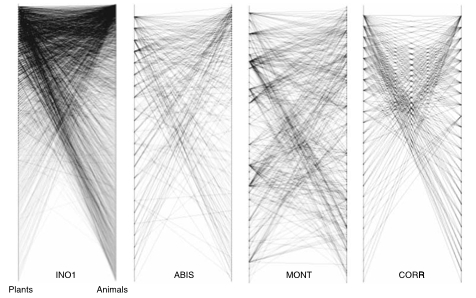Jordano, P., Bascompte, J. and Olesen, J.M. 2003. Invariant properties in coevolutionary networks of plant–animal interactions. Ecology Letters 6: 69–81.
 Plant–animal
mutualistic networks are interaction webs consisting of two
sets of entities, plant and animal species, whose evolutionary dynamics
are deeply influenced by the outcomes of the interactions, yielding a diverse
array of coevolutionary processes. These networks are two-mode networks
sharing many common properties with others such as food webs, social, and
abiotic networks. Here we describe generalized patterns in the topology
of 29 plant–pollinator and 24
plant–frugivore networks in natural communities. Scale-free properties
have been described for a number of biological, social, and
abiotic networks; in contrast, most of the plant–animal mutualistic
networks (65.6%) show species connectivity distributions (number of links
per species) with a power-law regime but decaying as a marked cut-off,
i.e. truncated power-law or broad-scale networks and few (22.2%) show scale-invariance.
We hypothesize that plant–animal mutualistic networks follow a build-up
process similar to complex abiotic nets, based on the preferential attachment
of species. However, constraints in the addition of links such as morphological
mismatching or phenological uncoupling between mutualistic
partners, restrict the number of interactions established, causing deviations
from scale-invariance. This reveals generalized topological patterns characteristic
of self-organized complex systems. Relative to scale-invariant networks,
such constraints may confer higher robustness to the loss of keystone species
that are the backbone of these webs.
Plant–animal
mutualistic networks are interaction webs consisting of two
sets of entities, plant and animal species, whose evolutionary dynamics
are deeply influenced by the outcomes of the interactions, yielding a diverse
array of coevolutionary processes. These networks are two-mode networks
sharing many common properties with others such as food webs, social, and
abiotic networks. Here we describe generalized patterns in the topology
of 29 plant–pollinator and 24
plant–frugivore networks in natural communities. Scale-free properties
have been described for a number of biological, social, and
abiotic networks; in contrast, most of the plant–animal mutualistic
networks (65.6%) show species connectivity distributions (number of links
per species) with a power-law regime but decaying as a marked cut-off,
i.e. truncated power-law or broad-scale networks and few (22.2%) show scale-invariance.
We hypothesize that plant–animal mutualistic networks follow a build-up
process similar to complex abiotic nets, based on the preferential attachment
of species. However, constraints in the addition of links such as morphological
mismatching or phenological uncoupling between mutualistic
partners, restrict the number of interactions established, causing deviations
from scale-invariance. This reveals generalized topological patterns characteristic
of self-organized complex systems. Relative to scale-invariant networks,
such constraints may confer higher robustness to the loss of keystone species
that are the backbone of these webs.
| Photo: Bipartite graphs depicting two-mode networks characteristic of plant–animal mutualistic interactions. Species in each set (nodes arranged along the vertical lines and connected by thin oblique lines) are sorted in decreasing number of interactions per species. Two plant– pollinator networks (left) and two plant–frugivore networks. |